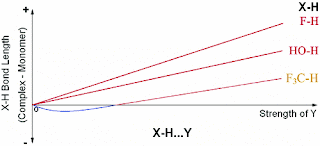Electronegativity is a simple and profound concept for understanding and giving a semi-quantitative description of broad classes of chemical bonds. It reflects the brilliant intuition of Linus Pauling who first introduced it in 1932. The bold idea is to assign a single number to each element of the periodic table; the relative value of the number between two elements then determines the magnitude of the polarity (charge distribution) in a chemical bond between two different elements.
I have been reviewing the concept because it is a key element to understanding hydrogen bonds, the recent IUPAC definition stating:
the hydrogen bond is an attractive interaction between a hydrogen atom from a molecule or a molecular fragment X-H in which X is more electronegative than H, ...
Unlike earlier definitions it does not require that the acceptor be more electronegative than H, only that for X-H...Y-Z
the acceptor is an electron-rich region such as, but not limited to, a lone pair in Y or a pi-bonded pair in Y-Z.
The
Wikipedia page on electronegativity is a helpful introduction but I found section 6.4 in the classic
Coulson's Valence extremely helpful.
There are several alternative definitions of electronegativity (Pauling, Mulliken, Alfred-Ronnow, Allen, ...). This highlights a few things:
-like most intuitive chemical concepts they are not something that can be defined rigorously, without ambiguity, or in a reductionist manner (a point
highlighted by Roald Hoffmann)
-the concepts are useful for understanding semi-quantitative trends
-these different definitions actually highlight the power of the concept because they show how a wide range of chemical and physical properties (bonding energies, dipole moments, charge distributions, ...) are correlated.
The graph below shows Pauling vs. Mulliken electronegativities
The "clearest" and most "precise" definition is that of Mulliken, where the electronegativity is the average of the ionisation energy and the electron affinity of the atom. This equals half of the ground state energy difference between the cation and the anion.
This means that if A and B have the same electronegativity that the ionic valence bond (VB) structures A+B- and A-B+ will have the same energy and so contribute equally to the full VB wave function, leading to no charge polarity.
To me the success of the concept also highlights the fact that predominantly
chemical bonding is local.
Like most chemical concepts there are
exceptions to their naive application. For example, carbon is less electronegative than oxygen, and so one might expect that in carbon monoxide (CO) there would be a net negative charge on the oxygen atom. However, the
opposite is true.





